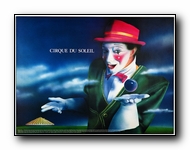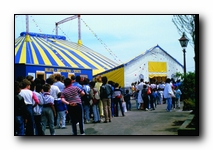

| |
 |
1986 |

COMMEDIA DELL’ARTE COMES TO THE CIRCUS
The Cirque du Soleil was born of heady ambition, the desire to capture
the marvelous, to seize two hours of magic from life. Because it offers
entertainment for all ages, adults and children alike share a moment of
enchantment. Outside the ring, after we had removed our makeup and the stage
lights were off, we put this 1986 show together with one goal in mind – to
cast a spell on the audience the moment they enter the big top. We offer
abandon, magic moments when time stands still. This year, the Cirque du
Soleil is making a major breakthrough in its brief career. Barely into our
third season, we are already conquering new horizons; embarking on a tour
that will take us to Vancouver. Part of this new momentum is the common
will shared by performers and administrators to make the Cirque du Soleil
a unique and solid cultural institution, as well as a business that contributes
to the economy. Our show has been created with love and spirit; we have always
felt that our country should have its own circus and all our efforts have been
directed to making this dream come true! – Guy Laliberte.


 Inspired by the best of what was happening internationally, in 1986 Cirque
creates a new theatricality and adopted a vision whereby rules exist only to
be broken. Guy Caron brings in Franco Dragone to teach Cirque artists commedia
dell'arte. The mandate is clear: to produce a European-style professional show
anchored in acrobatics, with original music and without animals. From the
Chinese they learned about perfecting the blend of presentation, music and
choreography--about grace and beauty, gestures and smiles. Cirque drew upon
an impressionistic sensibility, took everything that had existed in the past,
and pulled it into today.
Inspired by the best of what was happening internationally, in 1986 Cirque
creates a new theatricality and adopted a vision whereby rules exist only to
be broken. Guy Caron brings in Franco Dragone to teach Cirque artists commedia
dell'arte. The mandate is clear: to produce a European-style professional show
anchored in acrobatics, with original music and without animals. From the
Chinese they learned about perfecting the blend of presentation, music and
choreography--about grace and beauty, gestures and smiles. Cirque drew upon
an impressionistic sensibility, took everything that had existed in the past,
and pulled it into today.
In response to all that it has learned, Cirque du soleil revamps their young show into
La Magie Continue, and stages it in
eight cities across Canada, including the Children's Film Festival in British Columbia,
and in Vancouver, where it puts on several performances representing Canadian heritage
as part of the festivities surrounding Expo'86. The gamble propels Cirque to new heights
in attendance and success. The breakthrough came because Cirque appeared with its French
name to reflect its roots and tradition, David said. "It was a good decision, because
people in Toronto heard about us through the media, and when we came back to Toronto we
sold out. We also achieved one of our goals which was to be recognized as a national
institution." That success also allowed them to take risks – for the first time in
Cirque history they extended an invitation to the Chinese government to have a team of
its most talented acrobats take part. That invitation grew into the Spinning Meteor
performance and a life-long partnership with the Chinese arts.
Cirque du Soleil makes its name on the
international stage too, as acts are awarded top honors at competitions and
festivals around the world. Denis Lacombe, from the Ecole nationale
de cirque, wins a bronze medal for his "orchestra conductor" number at the Festival
du Cirque de Demain in Paris. And as interest in Cirque du Soleil grows, so does
the big top. The Cirque bought the 30-ton, $300,000 big top in April 1985 from
a company of Italian specialists. "No one in Canada can manufacture this kind of tent,
tent specialist Richard Bouthillier said in an interview. Designed to fit into a
modified tractor-trailor, it seats 1,500 and takes between 24 and 48 hours to put up
depending on temperature, winds and the efficiency of local crews. "We're starting a
circus tradition in Canada," Bouthillier says proudly. Like many veterans of Le Cirque,
he learned his craft in Europe. In his case, this meant travelling to Switzerland to
spend time with Marcel Rossell, tent master of the renowned Circus Knie. "He's one of
the best in the world," Bouthillier said. "I visited him in 1984 and 1985 and was with
him from morning to night. He taught me everything."
Yes, Cirque gained some traction, but it had its appetite set on bigger sights:
The United States. And they knew just where to go. To conquer the land south of
the border, Cirque began to think of ways to re-invent the circus.


|
|
|
|


![]()





![[Back]](../images/arrow.gif)








